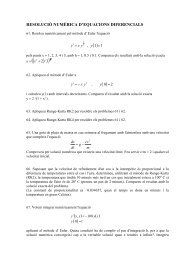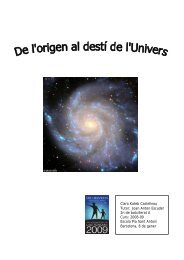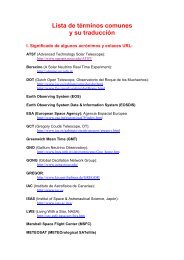Universitat de - Departament d'Astronomia i Meteorologia ...
Universitat de - Departament d'Astronomia i Meteorologia ...
Universitat de - Departament d'Astronomia i Meteorologia ...
You also want an ePaper? Increase the reach of your titles
YUMPU automatically turns print PDFs into web optimized ePapers that Google loves.
44 Chapter 2. Multiwavelength approach to LS 5039<br />
and 51176, when the flux <strong>de</strong>nsity of LS 5039 seemed to have varied by more than a<br />
factor of ∼ 2 on less than one day. However, inspection of the GBI operational notes<br />
reveals that technical problems such as cryogenics warming, or weather problems<br />
such as snow on the dishes, were responsible of this behavior. The apparent bump<br />
between MJD 51180 and MJD 51200 is also a result of cryogenics warming. Hence,<br />
it seems that most of the features in the lightcurve are due to technical problems,<br />
because of the relatively low flux <strong>de</strong>nsity of the source.<br />
Nevertheless, since Pooley et al. (1999) could <strong>de</strong>tect the 5.6 d orbital period<br />
of Cygnus X-1 in similar radio lightcurves, we have performed a timing analysis of<br />
the LS 5039 lightcurves at both frequencies. Given the span of the observations,<br />
the search was restricted between 2 and 100 d. The methods employed were the<br />
Phase Dispersion Minimization (PDM) (Stellingwerf 1978) and the CLEAN algo-<br />
rithm (Roberts et al. 1987). Unfortunately, no convincing period was <strong>de</strong>tected in<br />
this process. In particular, we do not <strong>de</strong>tect the 4.117 d orbital period recently<br />
found by McSwain et al. (2001) from radial velocity measurements. Folding of the<br />
data with such a period does not reveal any significant difference on radio emission<br />
along the orbit. Since the orbit is quite eccentric (e=0.41), and this is a wind fed<br />
system (where the primary does not fill its Roche lobe), we expect the accretion rate<br />
onto the compact object to change significantly between periastron and apastron.<br />
Hence, the non <strong>de</strong>tection of the orbital period in the GBI data can be attributed to<br />
its relatively high noise due to several facts (intrinsic measurement noise, technical<br />
problems, weather conditions, etc.).<br />
Although the 8.3 GHz data is dominated by noise, we can extract some infor-<br />
mation about the spectral in<strong>de</strong>x. The weighted mean of individual spectral indices<br />
is found to be α = −0.4 ± 0.3. On the other hand, if we use the mean flux <strong>de</strong>nsities<br />
at both frequencies we obtain a spectral in<strong>de</strong>x of α = −0.6 ± 0.4. These value<br />
are in good agreement with the results presented in Sect. 2.4.2 (Martí et al. 1998)<br />
obtained a few months before, thus suggesting that the non-thermal radio spectrum<br />
is a persistent property of the source.<br />
Set2 data<br />
This data set is not useful for timing analysis or other purposes due to its limited<br />
time span and total number of points. However, we have explicitly inclu<strong>de</strong>d the






